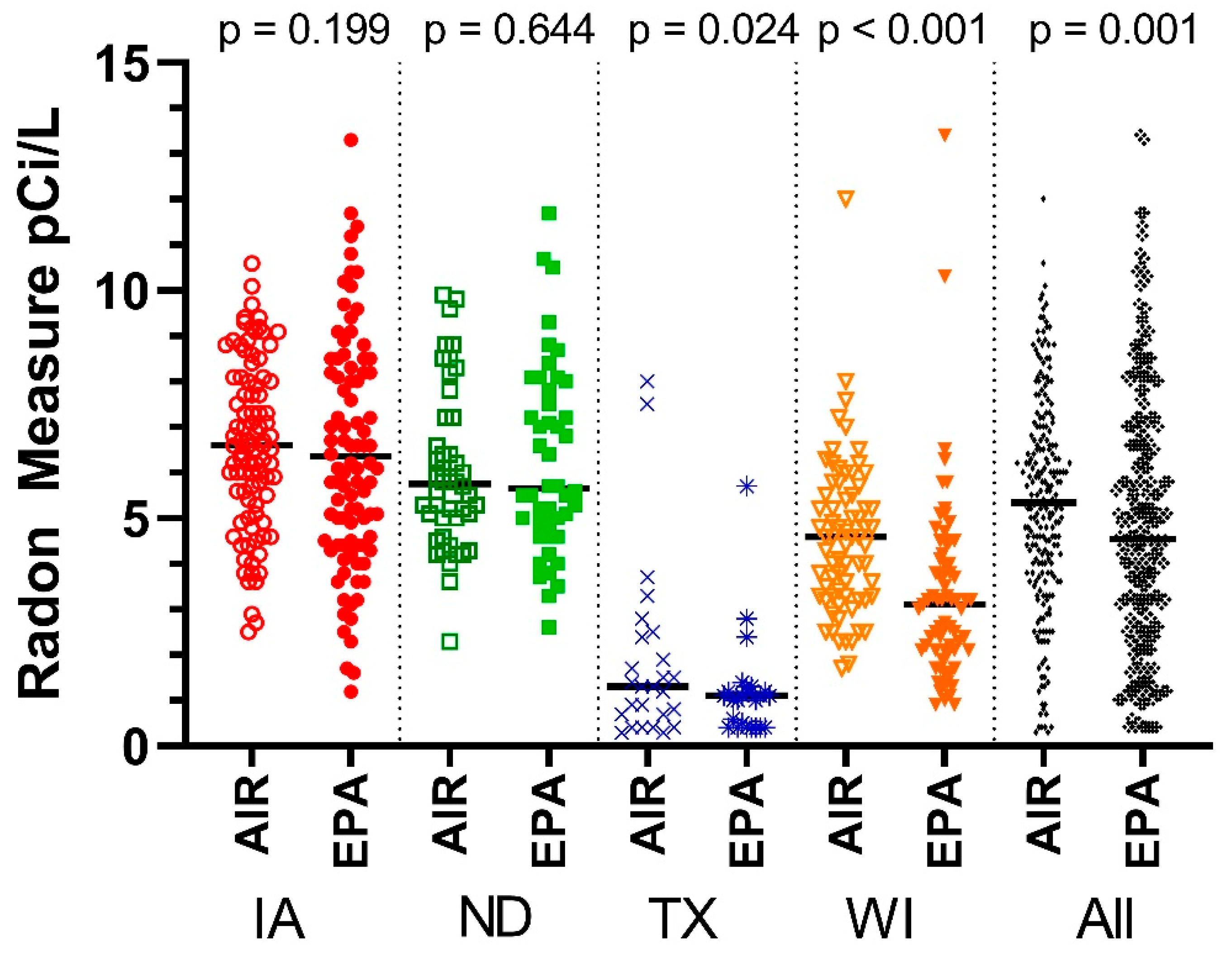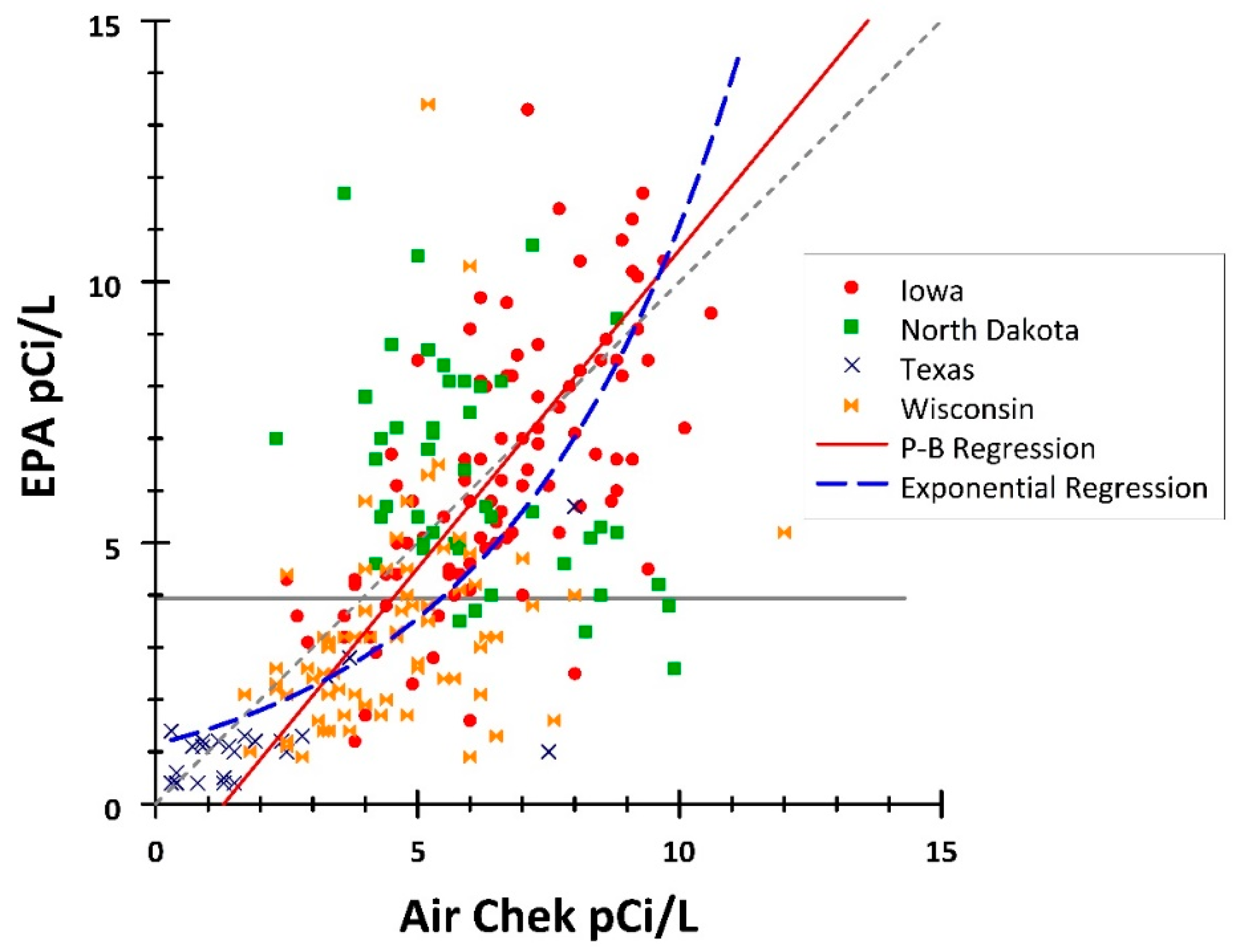Criterion Validity of Radon Test Values Reported by a Commercial Laboratory versus the Environmental Protection Agency
Abstract
:1. Introduction
2. Materials and Methods
2.1. Data
2.2. Statistical Analysis
3. Results
3.1. Paired Comparisons
3.2. Criterion Validity
4. Discussion
5. Conclusions
Author Contributions
Funding
Institutional Review Board Statement
Informed Consent Statement
Data Availability Statement
Conflicts of Interest
References
- Environmental Protection Agency. EPA Assessment of Risk from Radon in Homes. Available online: https://www.epa.gov/sites/default/files/2015-05/documents/402-r-03-003.pdf (accessed on 15 November 2021).
- Field, R.W.; Krewski, D.; Lubin, J.H.; Zielinski, J.M.; Alavanja, M.; Catalan, V.S.; Klotz, J.B.; Létourneau, E.G.; Lynch, C.F.; Lyon, J.L.; et al. An overview of the North American residential radon and lung cancer case-control studies. J. Toxicol. Environ. Health A 2006, 69, 599–631. [Google Scholar] [CrossRef]
- Mozzoni, P.; Pinelli, S.; Corradi, M.; Ranzieri, S.; Cavallo, D.; Poli, D. Environmental/Occupational Exposure to Radon and Non-Pulmonary Neoplasm Risk: A Review of Epidemiologic Evidence. Int. J. Environ. Res. Public Health 2021, 18, 466. [Google Scholar] [CrossRef]
- Gomez-Anca, S.; Barros-Dios, J.M. Radon Exposure and Neurodegenerative Disease. Int. J. Environ. Res. Public Health 2020, 17, 7439. [Google Scholar] [CrossRef]
- Zhang, Y.; Lu, L.; Chen, C.; Field, R.W.; D’Alton, M.; Kahe, K. Does protracted radon exposure play a role in the development of dementia? Environ. Res. 2022, 210, 112980. [Google Scholar] [CrossRef] [PubMed]
- USGS. Geological Radon Potential of EPA Region 8; USGS: Reston, VA, USA, 1993.
- EPA. National Residential Radon Survey Summary Report; EPA: Washington DC, USA, 1992.
- North Dakota Department of Health. Radon Home Survey in North Dakota—1988. Available online: https://web.archive.org/web/20150419130329/http://www.ndhealth.gov/aq/iaq/radon/Home88.htm (accessed on 15 November 2021).
- Monastero, R.N.; Meliker, J.R. Incidence of brain and spinal cord cancer and county-level radon levels in New Jersey, Wisconsin, Minnesota, Pennsylvania, and Iowa, USA. Environ. Geochem. Health 2020, 42, 389–395. [Google Scholar] [CrossRef] [PubMed]
- Oakland, C.; Meliker, J.R. County-Level Radon and Incidence of Female Thyroid Cancer in Iowa, New Jersey, and Wisconsin, USA. Toxics 2018, 6, 17. [Google Scholar] [CrossRef] [PubMed] [Green Version]
- Environmental Protection Agency. A Citizen’s Guide to Radon. Available online: Epa.gov/sites/default/files/2016-12/documents/2016_a_citizens_guide_to_radon.pdf (accessed on 15 November 2021).
- Iowa Department of Public Health. Iowa Department of Public Health Resources. Available online: http://idph.iowa.gov/radon/resources (accessed on 15 November 2021).
- Texas Department of Health; Southwest Texas State University. Final Report of The Texas Indoor Radon Survey; Texas Department of Health: Austin, TX, USA, 1994.
- Environmental Protection Agency. EPA’s Map of Radon Zones: Wisconsin; EPA: Washington, CA, USA, 1993.
- Vetter, T.R.; Cubbin, C. Psychometrics: Trust, but Verify. Anesth. Analg. 2019, 128, 176–181. [Google Scholar] [CrossRef]
- Sun, K.; Majdan, M.; Field, D.W.; Field, R.W. Field comparison of commercially available short-term radon detectors. Health Phys. 2006, 91, 221–226. [Google Scholar] [CrossRef] [Green Version]
- Kellenbenz, K.R.; Shakya, K.M. Spatial and temporal variations in indoor radon concentrations in Pennsylvania, USA from 1988 to 2018. J. Environ. Radioact. 2021, 233, 106594. [Google Scholar] [CrossRef] [PubMed]
- Conley, N. Seasonality, Atmospheric Conditions, and Variation in Household Radon, 1990–2015. Ph.D. Thesis, University of Kentucky, Lexington, KY, USA, 2019. [Google Scholar]
- Stanley, F.K.T.; Irvine, J.L.; Jacques, W.R.; Salgia, S.R.; Innes, D.G.; Winquist, B.D.; Torr, D.; Brenner, D.R.; Goodarzi, A.A. Radon exposure is rising steadily within the modern North American residential environment, and is increasingly uniform across seasons. Sci. Rep. 2019, 9, 18472. [Google Scholar] [CrossRef] [PubMed] [Green Version]
- Antignani, S.; Venoso, G.; Ampollini, M.; Caprio, M.; Carpentieri, C.; Di Carlo, C.; Caccia, B.; Hunter, N.; Bochicchio, F. A 10-year follow-up study of yearly indoor radon measurements in homes, review of other studies and implications on lung cancer risk estimates. Sci. Total Environ. 2021, 762, 144150. [Google Scholar] [CrossRef] [PubMed]
- Vasilyev, A.V.; Yarmoshenko, I.V.; Zhukovsky, M.V. Low air exchange rate causes high indoor radon concentration in energy-efficient buildings. Radiat. Prot. Dosim. 2015, 164, 601–605. [Google Scholar] [CrossRef] [PubMed]
- Zahnd, W.E.; Mueller-Luckey, G.S.; Ratnapradipa, K.; Smith, T. Predictors and Spatial Variation of Radon Testing in Illinois, 2005–2012. J. Public Health Manag. Pract. 2018, 24, e1–e9. [Google Scholar] [CrossRef] [PubMed]
- Stanifer, S.R.; Rayens, M.K.; Wiggins, A.; Hahn, E.J. Social Determinants of Health, Environmental Exposures and Home Radon Testing. West. J. Nurs. Res. 2021. [Google Scholar] [CrossRef] [PubMed]
- Kendall, G.M.; Miles, J.C.H.; Rees, D.; Wakeford, R.; Bunch, K.J.; Vincent, T.J.; Little, M.P. Variation with socioeconomic status of indoor radon levels in Great Britain: The less affluent have less radon. J. Environ. Radioact. 2016, 164, 84–90. [Google Scholar] [CrossRef] [PubMed] [Green Version]


| Correlation Measures | Kendall’s Tau | 95% CI | Lin’s Concordance | 95% CI | ||
| LL | UL | LL | UL | |||
| Four States (n = 236) | 0.490 | 0.423 | 0.552 | 0.600 | 0.516 | 0.673 |
| Iowa (n = 93) | 0.516 | 0.408 | 0.609 | 0.616 | 0.485 | 0.720 |
| North Dakota (n = 46) | −0.241 | −0.419 | −0.046 | −0.380 | −0.598 | −0.109 |
| Texas (n = 26) | 0.436 | 0.188 | 0.631 | 0.562 | 0.336 | 0.727 |
| Wisconsin (n = 71) | 0.334 | 0.187 | 0.467 | 0.278 | 0.094 | 0.444 |
| ≥4.0 (n = 135) | 0.259 | 0.150 | 0.361 | 0.304 | 0.148 | 0.446 |
| <4.0 (n = 101) | 0.500 | 0.395 | 0.592 | 0.348 | 0.248 | 0.440 |
| Passing–Bablok Regression | Intercept | 95% CI | Slope | 95% CI | ||
| LL | UL | LL | UL | |||
| Four States (n = 236) | −1.583 | −2.372 | −0.913 | 1.220 | 1.083 | 1.370 |
| Iowa (n = 93) | −3.095 | −5.050 | −1.232 | 1.407 | 1.147 | 1.688 |
| North Dakota (n = 46) | −3.060 | −27.90 | 2.862 | 1.700 | 0.567 | 6.000 |
| Texas (n = 26) | 0.220 | 0.121 | 0.730 | 0.533 | 0.200 | 0.697 |
| Wisconsin (n = 71) | −0.993 | −2.709 | 0.404 | 0.933 | 0.630 | 1.364 |
| ≥4.0 (n = 135) | −0.879 | −2.750 | 0.671 | 1.172 | 0.929 | 1.500 |
| <4.0 (n = 101) | 0.288 | 0.169 | 0.715 | 0.488 | 0.394 | 0.576 |
Publisher’s Note: MDPI stays neutral with regard to jurisdictional claims in published maps and institutional affiliations. |
© 2022 by the authors. Licensee MDPI, Basel, Switzerland. This article is an open access article distributed under the terms and conditions of the Creative Commons Attribution (CC BY) license (https://creativecommons.org/licenses/by/4.0/).
Share and Cite
Schwartz, G.G.; Klug, M.G.; Williamson, M.R.; Schwartz, H.M. Criterion Validity of Radon Test Values Reported by a Commercial Laboratory versus the Environmental Protection Agency. Int. J. Environ. Res. Public Health 2022, 19, 3615. https://doi.org/10.3390/ijerph19063615
Schwartz GG, Klug MG, Williamson MR, Schwartz HM. Criterion Validity of Radon Test Values Reported by a Commercial Laboratory versus the Environmental Protection Agency. International Journal of Environmental Research and Public Health. 2022; 19(6):3615. https://doi.org/10.3390/ijerph19063615
Chicago/Turabian StyleSchwartz, Gary G., Marilyn G. Klug, Mark R. Williamson, and Heather M. Schwartz. 2022. "Criterion Validity of Radon Test Values Reported by a Commercial Laboratory versus the Environmental Protection Agency" International Journal of Environmental Research and Public Health 19, no. 6: 3615. https://doi.org/10.3390/ijerph19063615
APA StyleSchwartz, G. G., Klug, M. G., Williamson, M. R., & Schwartz, H. M. (2022). Criterion Validity of Radon Test Values Reported by a Commercial Laboratory versus the Environmental Protection Agency. International Journal of Environmental Research and Public Health, 19(6), 3615. https://doi.org/10.3390/ijerph19063615






